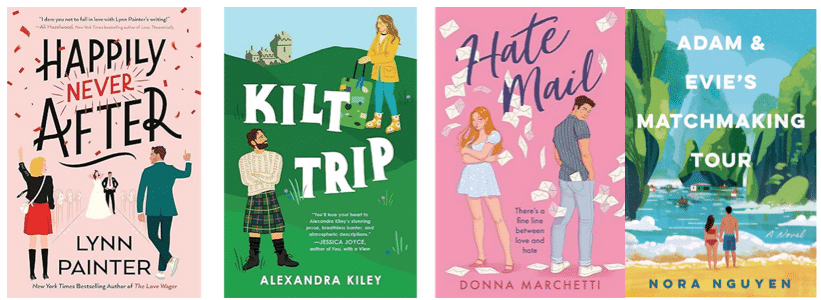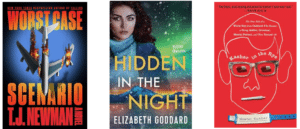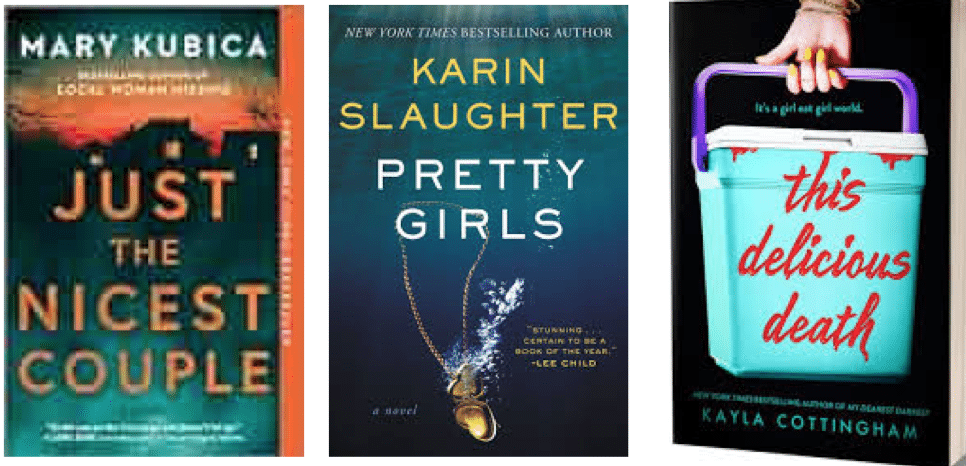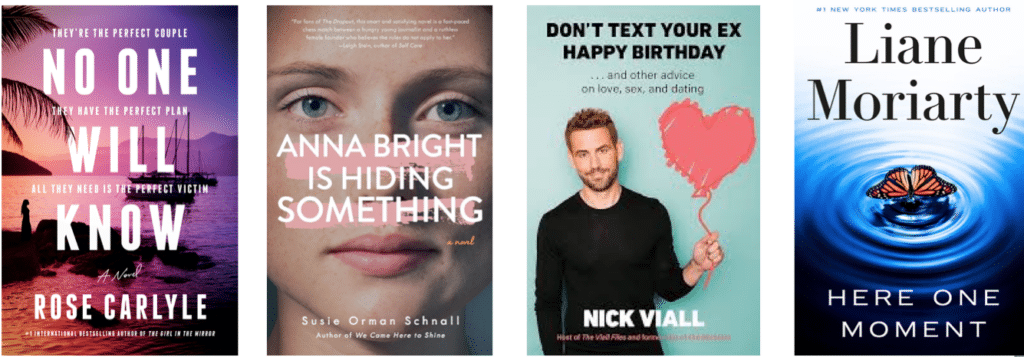In Romeo and Juliet, William Shakespeare writes this line from Juliet to Romeo:
What’s in a name? That which we call a rose
By any other name would smell as sweet.
Likewise, authors sometimes wish readers would judge our books purely based on prose, character, and plot. But let’s face it, readers are often swayed by an eye-catching book cover or a clever title.
The reality is that there are millions of books competing for a spot on the same bookshelves and book club lists. So, the distinctiveness and appeal of your book’s title, cover, and premise (in the form of a blurb), make a difference in the reader’s purchase decision.
The good news?
We’re writers!
If you get to have a say in your book’s title, consider it a fun writing challenge. A mini poem. A taut few words that capture the essence of your book’s tension, theme, or the thing that will make a reader take notice. For instance, Jodi Picoult and Jennifer Finney Boylan’s book title Mad Honey refers to a hallucinogenic honey. The words intriguingly pair an image of delicious nectar with the idea of being unhinged. Main character Olivia explains, “The secret weapon of mad honey, of course, is that you expect it to be sweet, not deadly.”
It’s not easy
First of all, let’s acknowledge that naming isn’t always easy. When I was marketing some of the world’s most iconic snack brands, we’d often hire naming agencies to help devise the name that would telegraph the brand promise while carrying enough uniqueness to break through and enough familiarity to feel relatable. That’s a tough dichotomy. Then, we’d spend loads of advertising and promotion dollars to build awareness in that name to drive conversion.
Get clever!
Let’s be real. A single book (or series) can rarely afford the same level of investment as a consumer goods brand. So what’s an author to do instead? Get clever! For instance, you can hint at a well-known saying to trigger that feeling that they’ve heard the phrase before (without being either too predictable or forgettable). Or write the title the way you’d write a joke—have the ending be an unexpected rug pull. Take Thursday Murder Club, where the first two words suggest the mystery genre. But the lighthearted ending, “Club,” unexpectedly brings to mind a ladies club or social club, hinting that there’s humor in the book.
Of course, don’t be clever just for the sake of being clever. The title (and cover) must be true to the story itself. You must deliver on the expectations that the title generates. Otherwise, you risk confusing or disappointing your readers.
Start with strategy
Just as with any other creative exercise, you can employ a guided approach to a naming exercise. First, start with clarity of your “brief,” or summary of what you’re trying to accomplish. I won’t be able to fully cover the art of writing a brilliant brief here, but suffice it to say that you should clearly articulate strategic choices like:
- Who’s your target (demographics, psychographics)? What’s their need that you’re fulfilling?
- What’s the distinct difference in your book? Its logline?
- What are titles in your genre that you feel would be a fit? Why?
- What titles would be a definite “no?” Why?
Iterate and brainstorm
Get in a relaxed place, give yourself the permission to be playful, silly, wild, and even wrong. One option is to recruit a creative partner you are comfortable with to join you (their new perspective can be a breath of fresh air), or use an AI model to kickstart your brainstorm with some ideas (just be careful not to enter anything you’d consider sensitive, confidential, or proprietary into a public tool, which can train the model and reveal your content to others).
The key to a brainstorm is to aim for quantity over quality. Brainstorm against different themes; for example:
- What’s your main character’s dilemma? (Sophie’s Choice)
- What’s the transformation the character must go through? (The Metamorphosis)
- What’s the worst thing they fear? (The Year of Living Dangerously)
- If setting is a key character in your book, is there something iconic that you’d want to call out? (Breakfast at Tiffany’s)
- What would pull on a reader’s emotions or curiosity? (The Invisible Life of Addie LaRue)
Strive to have options that fall along the divergent ends of a uniqueness and familiarity continuum. Write them all down. Don’t delete or judge in the moment, that’s for later.
Uniqueness ← → Familiarity
If you aim for uniqueness, your title will be more distinct. However, this usually will require time and funds to build awareness. For example, when Chris Van Allsburg first published the children’s book Jumanji in 1981, he says the made-up name came to him as he tried to conceive “something slightly exotic and something that evoked the idea of the jungle.” The unusual name could serve to catch attention. But, because the title had no known meaning when it was launched, it also didn’t convey much intrinsic meaning. Over time, as the book was adapted to TV and film, the word entered into our cultural zeitgeist and has even been included in Saturday Night Live spoofs.
On the flip side, if your title sounds too much like something else, you could create confusion and get lost in the noise. For example, my debut novel’s working title was initially Missing Pieces because my main protagonist must regain his sense of self after losing limbs in a train accident. However, a quick Amazon search uncovered more than a dozen books with this name, including a children’s book and some thrillers. I abandoned this name not only because it’s not unique, but also because it felt too “on the nose” and missed the emotional tension that main character Phoenix is afraid to reveal his disability to the woman he loves, Orchid. The opening line to the book, “Phoenix never believed today was goodbye,” inspired the final title, Goodbye, Orchid. This carries much more emotional resonance and mystique.
As with most things, balance is key. Strive for a balance between uniqueness and familiarity. In most cases, it’s best to keep the title short, which will make it easier for readers to recall.
Gain some distance
Once you have a list of contenders, congratulate yourself! You may let the options marinate for a bit before evaluating them. When you do assess, check them against the goals of your brief, not just “Do I like this?” (which can be subjective).
Evaluation
If you’ve narrowed your list to a handful of options, you can mock them up onto covers, and even enlist the opinions of readers who are in your target demographic. Do research on the titles you like, especially in your genre. Search them on Amazon, Barnes & Noble, or Goodreads. Are there already half a dozen with the same title, and therefore yours might get confused with an existing book? Do the words in your title auto-spell to something unsavory or confusing? At a quick glance, might your title be misread?
Inspiration in the wild
Here are some examples of titles and the clever techniques that they demonstrate.
Reference something that readers love, like books, libraries, or book clubs. Of course, to live up to the title, the story needs to deliver on that promise of having a library, bookstore, or book club in it!

Try a clever play on words that creates a double take. Case in point: instead of “happily ever after,” catch a reader’s attention with Happily Never After. Play off “guilt trip” with Kilt Trip, appropriately accompanied by a man in Scottish garb. Title a rom-com not Love Mail but the funnier Hate Mail. This sets up tension between the protagonists right from the book cover. The main characters’ names in Adam and Evie’s Matchmaking Tour seem familiar because of their similarity to Adam and Eve. See covers below.

Play off a well-known saying like Best Case Scenario/Worst Case Scenario. Instead of Hidden in Plain Sight, Elizabeth Goddard’s book is Hidden in the Night. Author Moshe Kasher brings attention to his last name by evoking the J.D. Salinger classic Catcher in the Rye with his title Kasher in the Rye.

Build tension through contradictions. For instance, these mystery/thriller books juxtapose sweet and scary. In Mary Kubica’s book, the neighborly saying Just the Nicest Couple is paired with an ominous house against a blood orange sky. Karin Slaughter’s innocuous Pretty Girls title hovers above a heart necklace diving to its depth. This Delicious Death is a conundrum in and of itself, as death isn’t normally considered “delicious.” Coupled with a cooler that has blood spilling out, the contradiction is jarring, surprising, and attention-getting.

Raise a question in the reader’s mind. No One Will Know makes you wonder, what won’t they know? Anna Bright is Hiding Something asks the question, what is she hiding? Don’t Text Your Ex Happy Birthday will catch the attention of would-be suitors—what else shouldn’t I do while dating? Lastly, when we see Here One Moment—inside our brains we think Gone the Next, which makes you curious about the outcome of the story.

Phew that was a lot! Now that you’re armed with the concepts behind naming, an approach to undertake your own brainstorming, and examples from the real world, go ahead and start generating titles. Strive to have your titles make William Shakespeare proud. Let me know how it goes.
________________________
Carol Van Den Hende is the award-winning author of the Goodbye, Orchid series, which draws from her Chinese American heritage and has won 40 literary and design awards. She also has an MBA and decades of experience in marketing, strategy, and insights, and is passionate about simplifying marketing concepts into actionable steps for publishing success. She’s keynoted and presented at conferences like Writer’s Digest, IBPA, International Women’s Writing Guild, Rutgers Writers’ Conference, Sisters-in-Crime, and Women Who Write.

